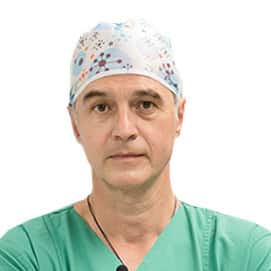Thyroid cancer in most cases (up to 70 - 80%) arises from follicular cells of the thyroid gland, these are cells of the thyroid gland's own epithelium (differentiated carcinoma). Among them, the most frequent (approximately 50%) are the so-called papillary carcinomas.
Slightly less common are the so-called follicular carcinomas (20 - 30%). Approximately 5-10% thyroid carcinomas arise from calcitonin-producing C cells located in the connective tissue between thyroid follicles (medullary or C-cell carcinomas). Also rare undifferentiated (anaplastic) carcinomas arise as well as differentiated carcinomas from thyroid follicular cells.
Initially, the tumor, depending on which tissue it occurs in, is limited to the thyroid gland. When the tumor becomes larger, it can break through the connective tissue capsule of the thyroid gland and affect nearby tissues, lymph nodes, or other organs. Through the lymphatic vessels and blood tract, single cancer cells can also reach distant organs. There they can settle and multiply again, so there are daughter tumors (metastases). In thyroid carcinoma, metastases most often occur in the lungs, liver, and bones.
The course of the disease depends largely on what form of thyroid carcinoma caused the disease. Papillary carcinoma grows relatively slowly and is initially limited to the thyroid gland. In the case of tumor spread, this occurs first through the lymphatic vessels to the surrounding lymph nodes, and only later does the tumor spread through the bloodstream and create distant metastases. In children with papillary carcinoma, a tumor that has grown beyond the thyroid capsule can lead to lung metastases early in the course of the disease, which can still often be treated well. In general, the chances of recovery from papillary carcinomas are very good.
Follicular carcinomas spread primarily through the bloodstream and produce daughter tumors predominantly in the lungs and bones. As long as the tumor is confined to the thyroid, the chances of recovery are excellent. But even with the appearance of metastases, recovery is often possible.
Medullary carcinomas can early metastasize to the cervical lymph nodes, and sometimes to the lymph nodes of the upper part of the chest. Metastases from cancer cells brought by the bloodstream appear primarily in the liver, lungs and bones. The chances of recovery are 50 - 60%, and with early recognized carcinomas that have not yet metastasized - more than 90%.
Very aggressive undifferentiated (anaplastic) carcinoma on the contrary, it progresses rapidly and metastasizes early to the liver, lungs, bones, and brain. The prognosis is correspondingly unfavorable.
Thyroid cancer - staging
The stage of the spread of the tumor is an important criterion in choosing the best suitable treatment method. For a more accurate description of the tumor, it is divided into stages depending on the distribution. The division occurs into certain categories, in which everyone determines three main points:
- Tumor size (T)
- Node involvement (N)
- Presence of metastases (M)
Therefore, the term TNM classification is used. The numbers after the letters give an accurate indication of the size and spread of the tumor (T1-4), the number and location of the affected lymph nodes (N1 or N2) and the presence or absence of distant metastases (M0 or M1). T1 N0 M0 in this case means that we are talking about a small tumor limited to the thyroid gland without damage to the lymph nodes and without metastases. Also in the TNM classification of the thyroid gland, the age of the patient is taken into account. Accurate determination of the TNM stage is often possible only after surgical removal of the tumor.
The next point that plays a role in characterizing the tumor is the structure of the cancerous tissue (grading). It is studied by microscopic examination of the taken tissues and gives an indication of the aggressiveness of the tumor. Microscopic examination also reveals the type of thyroid cancer.
Head of the Clinic for General, Visceral, Thoracic and Endocrine Surgery
Head of the Clinic for General, Visceral and Minimally Invasive Surgery
Video
Request appointment
Useful links
Photo gallery












